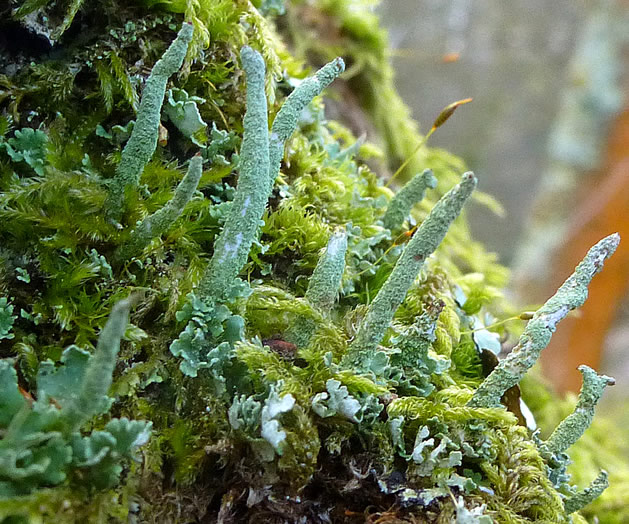 |
| Lichens |
Lichens are composed of two distinct species, a fungus and a photosynthetic alga (or bacterium) that have coevolved to live in a symbiotic relationship with each other as a single life-form that grows on rocks, trees, and other substrates.
Lichens are classified as members of the kingdom Fungi
Symbiosis
Symbiosis is an extreme form of an ecological relationship known as mutualism between members of different species, in which each partner in the union derives benefits from the other. In symbiotic unions, the partners are so dependent on each other they can no longer independently survive.
  |
In lichens, the fungal (mycobiont) symbiont provides protection, while the green-algal or bacterial (photobiont) symbiont provides sugars, created by photosynthesis. It is often suggested that the fungus in lichen species might also pass water and nutrients to the photobiont, but this function is less well documented.
This special relationship allows lichens to survive in many environments, such as hot deserts and frozen Arctic tundra, that are inhospitable to most other life-forms. As a result, the lichen whole is greater than the sum of its parts. While in nature lichen partners always exist together, under laboratory conditions it is possible to take the lichen apart and grow the two partners separately.
Anatomy
Whereas in most plant species the anatomy of the organism is identified with structures associated with a single vegetative body, the “lichen body” is more aptly described as a colony of cells that share a variety of associations with one another that vary from one species of lichen to the next.
 |
| Close up image of thick lichens and mosses |
In some species of lichen, fungal and algal cells merely coexist. Coenogonium leprieurii, for example, is a lichen that lives in low-light tropical and subtropical forests in which the filamentous green algal partner (Trebouxia) is dominant.
In most lichen species, however, the relationship between the symbiotic partners is more intimate, with the lichen body appearing to be a single entity. In these species the algal symbiont has no cell walls and is penetrated by filaments from the fungal symbiont called haustoria, which pass sugars from the algal cell to the fungal cell and may have a role in the transportation of water and nutrients from the fungal cell. This integration is so complete that many naturalists prior to the nineteenth century mistakenly classified lichens as mosses.
Inmost lichen species it is nevertheless possible, with a good magnifying device, to identify several distinct regions of the thallus or lichen body. The outermost region is the cortex, a compacted layer composed of short, thick hyphae (widely dilated filaments) of the fungal symbionts that protect the lichen from abiotic factors in its environment.
   |
These hyphae extend downward into a second region, the photobiont layer,where they surround the algal symbionts. Below this is a third region, the medulla, composed of a loosely woven network of hyphae.
Underneath this is a fourth region, the under cortex, that is similar in appearance and structure to the cortex. The bottom of the lichen body is composed of rhizines, root like structures composed of bundles of hyphae that attach the lichen to its substrate (the rock, bark, or other support on which it resides).
This arrangement of regions into layers serves to prevent water loss. Many species can survive complete desiccation, coming back to life when water becomes available again. The cortex also contains pseudocyphellae,which are pores that allow for the exchange of gases necessary for photosynthesis.
Life Cycle
 |
| Lichen life cycle |
Lichens typically live for ten years or more, and in some species the lichen body can survive for more than a hundred years. Reproduction in most fungal species proceeds by the development of a cup- or saucer-shaped fruiting body called an apothecium, which releases fungal spores to its surroundings. Procreation in lichens is more problematic in that the fungal off spring must also receive the right algal symbiont if they are to survive.
The most common form of dispersion in lichen is by the accidental breaking off of small pieces of the thallus called isidia, which are then spread by wind to new substrates. In some species, small outgrowths of the thallus known as soralia arise, composed of both fungi and algae and surrounded by hyphae, to form soredia, which after dispersion give rise to a new thallus.
Biological and Agricultural Importance
Lichens are excellent bioindicators of air pollution, as many species are particularly sensitive to certain contaminants in their surroundings, such as sulfur dioxide. They represent a major food source for reindeer in Lapland and are used as cattle fodder there as well.
One species of lichen (Umbilicaria esculenta) is considered a delicacy in Japan. Historically, lichens have been used as pigments for the dying of wool. The medical properties of some species of lichens for the treatment of lung disease and rabies have led to a renewed interest in them